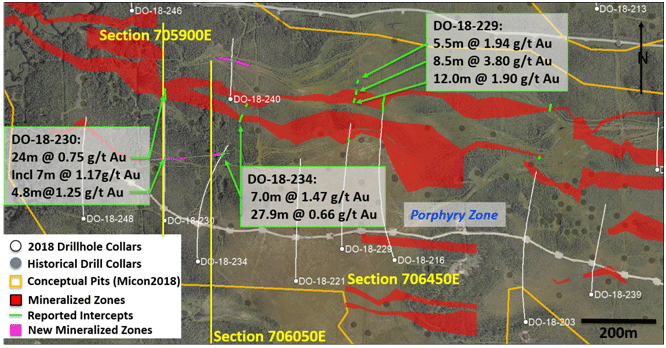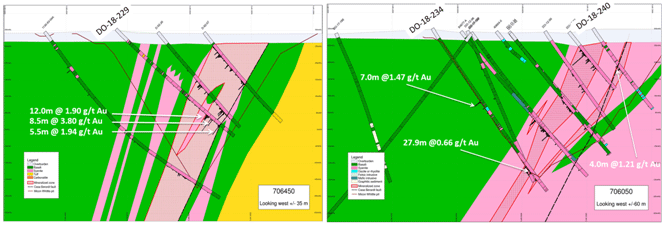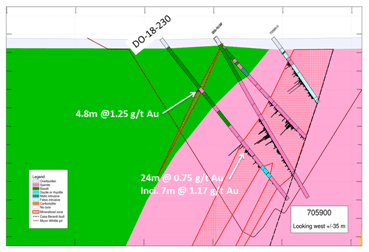By Cory댊
Maple Gold intersects several mineralized zones and extends mineralization at depth in west-central Resource Area
It’s a news heavy day for the resource sector. The news below is from Maple Gold Mines and follows nicely with the recent interview with the Company, posted yesterday (linked below). Although the assay results today are not in the same area as the prior results there is a lot of information. We need to remember this a large project consisting of a number of deposits. The goal is to tie together these deposits in the form of a super pit. High grade is not necessarily the main driver here as it is important to show consistency throughout.
I have received a number of emails and questions on the back of the interview but please keep them coming. I will be sure to get them addressed in my next call. Email me at Fleck@kereport.com.
Click here to listen to the past interview posted yesterday.
… Here’s the news for today…
June 26, 2018 – Montreal (Quebec): Maple Gold Mines Ltd. (“Maple Gold” or the “Company”) (TSX-V: MGM, OTCQB: MGMLF; Frankfurt: M3G) is pleased to report additional drill results from the western half of the Porphyry Zone within the current Resource Area at the Douay Property. Within this area (see Figure 1) a total of eight (8) infill and step-out holes were drilled in 2018, with assays pending for the westernmost hole of these only. Both geological observations and assay results for these new holes show good continuity of mineralization in this area, with several higher grade intervals, within a syenite dyke or dyke swarm in the hanging wall of one of the Casa Berardi Faults (see Figure 2).
- DO-18-229 cut several mineralized zones, including 12.0m of 1.90 g/t Au, 8.5m of 3.80 g/t Au (uncapped) and 5.5m of 1.94 g/t Au, all of which form part of a broader envelope of lower-grade halo mineralization which extends to surface in historical hole D-92-07 (see Figure 2A).
- DO-18-234 cut several mineralized zones, including an upper zone in basalt with 7.0m grading 1.47 g/t Au and a lower zone in syenite with 27.9m grading 0.66 g/t Au. The latter extends to surface in historical hole DO-05-02 (see Figure 2B)
- DO-18-230 also cut multiple mineralized zones, including an upper zone in basalt with 4.8m grading 1.25 g/t Auand a lower zone in syenite with 24.0m grading 0.75 g/t Au, including 7.0m grading 1.17 g/t Au. These zones also extend to surface in holes DO-12-97 and 70586-0, respectively (see Figure 2C)
In addition to the highlights mentioned above, several other drill-holes successfully confirmed both lateral and vertical continuity of mineralization (see Table 1: Highlighted Drill-Results to-date from the Western Portion of the Porphyry Zone, below).
Maple Gold’s President and CEO, Matthew Hornor, stated: “Infill and step-out drilling has successfully confirmed down-dip extensions of existing mineralized zones in the main Porphyry Zone. Further drill results are expected in the coming weeks from the Nika Zone, the eastern half of the Porphyry Zone and also from new greenfields drilling to the NE and NW of the Resource Area.”
Table 1: Highlighted 2018 Drill Results to-date from Western Portion of the Porphyry Zone (Newly reported drill-holes shaded grey)
Intervals given are all down-the hole lengths, which are estimated to be approximately 90% of true width. Coordinates are NAD83 Zone 17N. All assays were performed by ALS Laboratories by AU-ICP21, i.e. 30 g fire assay with ICP finish with any over limits (>10 g/t Au) redone by AU-GRA21, i.e. gravimetric analysis of 30g sample weight. Nominal cut-off to obtain intercepts is 0.25 g/t Au, but depending on grade distribution effective cut-offs can be somewhat higher or lower. All intercepts are uncapped, those identified with (*) include samples with overlimits (>10 g/t Au); which may be subject to grade capping during future resource estimation.
2018 drilling in the western half of the Porphyry Zone shows a broad (90-130m true width) halo of gold mineralization, extending several hundred meters along strike and mainly hosted in syenites (see Figures 1,2) within which higher grade (>1 g/t Au) intervals are found. In some cases the lower portion of the halo has the best grades (e.g. DO-18-229 shown in Figure 2A), in others the upper portion (DO-18-230 shown in Figure 2C). Narrow high grade structures are also found in basaltic wallrocks (Figure 2B).

Figure 1: Drill plan for western part of Porphyry Zone. Note previously reported hole DO-18-216 located 160m to the east of DO-18-229, and continuity of mineralized envelopes (current wireframes use a 0.1 g/t Au cut-off) between these holes. Note new mineralized zones (pink polygons), in areas previously classified as waste.


Figure 2 (A, B & C): Geological sections over an (EW) distance of 550m, with gold grade distribution shown as black bars. A (above left), Geological section for DO-18-229. Note continuity of broad mineralization envelope from the deepest intercepts in DO-18-229 right to surface. B (above right), Geological section for DO-18-234 and -240, note continuity of mineralization as well as new mineralized zone cutting the central part of the hole. C (below), Geological section for DO-18- 230, with the best grades some distance from the fault. Vertical gridlines are 200m apart, horizontal gridlines 50m.
In addition to confirming continuity of mineralization down-dip, these sections demonstrate that mineralization is still open at depth, and that additional resources can be defined further down-dip and still within the envelope of a conceptual pit (<500m depth). Furthermore, additional mineralized zones are still being found in syenite and in basalt wall rock, in areas previously classified as waste (Figure 2C left, Figure 3 below).

Qualified Person
The scientific and technical data contained in this press release was reviewed and prepared under the supervision of Fred Speidel, M. Sc, P. Geo., Vice-President Exploration, of Maple Gold. Mr. Speidel is a Qualified Person under National Instrument 43-101 Standards of Disclosure for Mineral Projects. Mr. Speidel has verified the data related to the exploration information disclosed in this news release through his direct participation in the …read more
From:: The Korelin Economic Report

